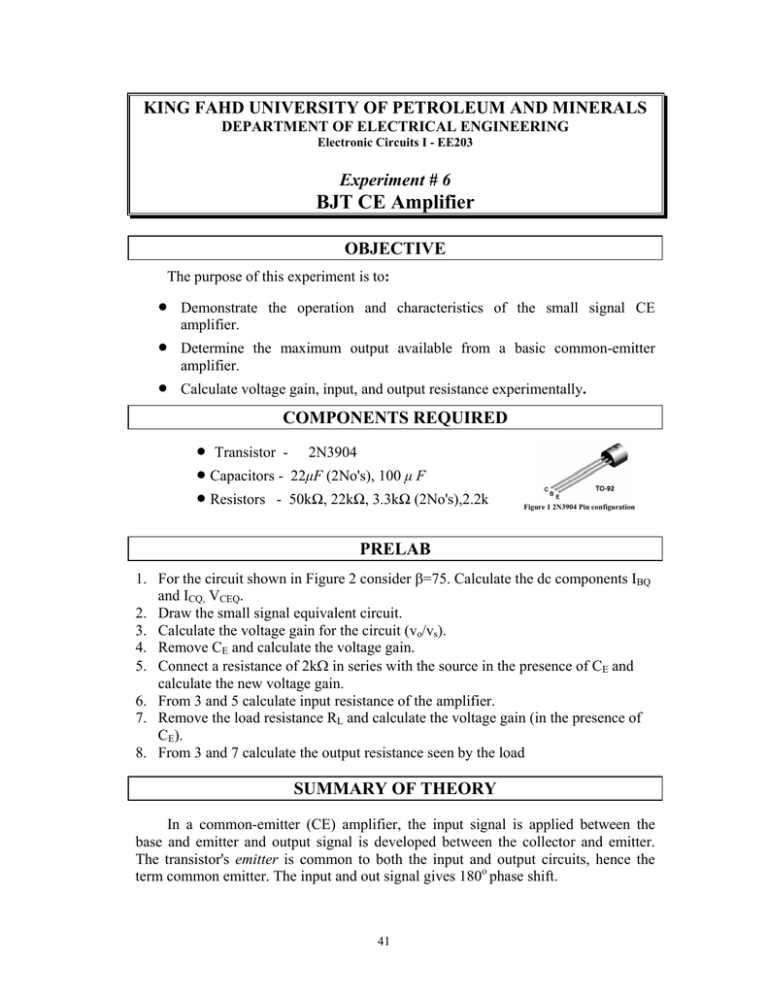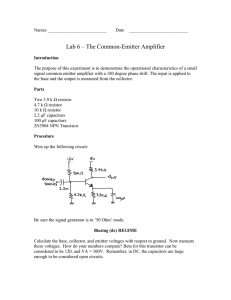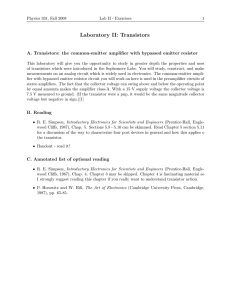ee 203 electronics i lab experiment 6
advertisement

KING FAHD UNIVERSITY OF PETROLEUM AND MINERALS DEPARTMENT OF ELECTRICAL ENGINEERING Electronic Circuits I - EE203 Experiment # 6 BJT CE Amplifier OBJECTIVE The purpose of this experiment is to: • Demonstrate the operation and characteristics of the small signal CE amplifier. • Determine the maximum output available from a basic common-emitter amplifier. • Calculate voltage gain, input, and output resistance experimentally. COMPONENTS REQUIRED • Transistor - 2N3904 • Capacitors - 22µF (2No's), 100 µ F • Resistors - 50kΩ, 22kΩ, 3.3kΩ (2No's),2.2k Figure 1 2N3904 Pin configuration PRELAB 1. For the circuit shown in Figure 2 consider β=75. Calculate the dc components IBQ and ICQ, VCEQ. 2. Draw the small signal equivalent circuit. 3. Calculate the voltage gain for the circuit (vo/vs). 4. Remove CE and calculate the voltage gain. 5. Connect a resistance of 2kΩ in series with the source in the presence of CE and calculate the new voltage gain. 6. From 3 and 5 calculate input resistance of the amplifier. 7. Remove the load resistance RL and calculate the voltage gain (in the presence of CE). 8. From 3 and 7 calculate the output resistance seen by the load SUMMARY OF THEORY In a common-emitter (CE) amplifier, the input signal is applied between the base and emitter and output signal is developed between the collector and emitter. The transistor's emitter is common to both the input and output circuits, hence the term common emitter. The input and out signal gives 180o phase shift. 41 To amplify ac signal, the base-emitter junction must be forward biased and the base-collector junction must be reverse-biased. The bias establishes and maintains the proper dc operating conditions for the transistor. After analyzing the dc conditions, the ac parameters for the amplifier can be evaluated. Figure 2, below shows the transistor configured as a common emitter amplifier. In this diagram, VS is the a.c. signal source, and RL is the load. VCC is a power supply, which provides the transistor with the necessary power to amplify the a.c. signal. Resistors R1 and R2 are used to establish the correct voltage at the base of the transistor. (See the text for more details.) The capacitors C1 and C2 serve to isolate the signal source and load from the voltage source VCC. (The capacitors are called “blocking capacitors” or “coupling capacitors”, since they block the d.c. voltage but act like a short to the a.c. signal.) EXPERIMENTAL WORK Before you connect the circuit test the transistor using DMM and curve Tracer, instructor will examine you procedure. DC analysis 1. 2. Wire the circuit as shown in Figure 2. The pin diagram for the 2N3904 transistor is shown in Figure 1. After you have checked all connections, apply the 10V supply voltage (you have to adjust the supply of 5-15V variable from beardboard to 10V using multimeter). Figure 2 3. With a multimeter, individually measure the transistor dc base, emitter and collector voltages and currents, record you results in table1. Findβ. Make sure 42 your transistor is biased in the active mode for amplifier application. Record your results in Table 1. Parameters VB VE VC IB IE IC Measured Value Theoritical Value Simulation Value Table1 Small Signal Analysis 4. 5. 6. 7. 8. 9. 10. 11. Apply a sine wave (10mV, 100 kHz) and measure the output voltage using the double beam oscilloscope. Display both input and output signals on the oscilloscope and observe the phase shift. Measure the output voltage and compute the voltage gain. (Avoid using Autoset of the oscilloscope, adjust manually, if the display is distorted due to the use of the 20dB attenuator) You must observe that the output signal level (Vout) is greater the input signal level (Vs). In addition, Vout is inverted or 180 degree out-of-phase, with respect to the input. Those points are two major characteristics of a commonemitter amplifier. Remove CE and calculate the voltage gain. Reconnect CE. Connect a 2kΩ resistance (RS) in series with the source and calculate the voltage gain in the presence of CE. Use the value obtained in step 2 with the one obtained here to calculate the input resistance. Remove the load resistance and calculate the voltage gain with CE connected. Summarize your results in Table 2. Compare results to the theoretical calculations and PSPICE simulation. Find the error percentages and discuss the factors that caused these errors. Attach theoretical and Pspice results with the report. Input and Output resistance can be calculated using. Ri / (Ri+Rs) =A3/A1 Ri---Input Resistance RL/ (RL+RO) =A1/A4 RO ---Output Resistance Record all your observations in table 2. CE Rs RL Vs(p-p) 100µF Without 100µF 100µF Without Without 2K Without 3.3K 3.3K 3.3K Without 20mV 20mV 20mV 20mV Vout(p-p) Table 2 43 Measured Gain Theoretical gain A1= A2= A3= A4= A1= A2= A3= A4= Simulation gain PSPICE WORK BIAS POINT DETAIL SIMULATION Use Schematics to connect the circuit shown in Figure 2. Analyze the circuit by choosing Analysis Æ Setup Æ Bias Point. Run the simulation by choosing Simulate from the Analysis menu (See the results from examine output choosing from file Menu). Write all the results in the following table. Vcc VB VE VC IB IE IC β α SMALL SIGNAL ANALYSIS Use Schematics to draw the amplifier circuit in Figure 2. For source Vs use VSIN from the Get New Part Menu. Double click the source and enter the values of peak voltage and frequency of 10mV and 1 kHz. Exactly follow the same procedure used in Lab. Write all the results in Table 2. 44


